This year we have seen a number of companies enter the widely expanding world of solid state drives. For this review Plextor is at the center of attention, who has recently released their first generation SSDs. The models include the 64GB PX-64M1S and the 128GB PX-128M1S, with our review focused on the 128GB model. How well will this model stack up against the completion? Read our full review to find out.
Technical Overview
Plextor PX-128M1S Specifications:
- Capacity: 128 GB
- Sequential Read: 130 MB/s maximum
- Sequential Write: 70 MB/s maximum
- Random Read (IOPS 4K): 4,300 maximum
- Random Write (IOPS 4K): 1,800 maximum
- Power Consumption: 0.75W (Read/Write), 0.25W (Idle)
- SMART Command Support: Supported
- DATA Encryption: Supported
- SATA Interface: SATA revision 2.6 compliant, support SATA 1.5 or 3Gb/s
- Firmware Upgrade: Supported
- Temperature: 0 to 70 ºC (Operating)
- Humidity: 5% to 95%
- Altitude: -400 to 24,384 meter
- Reliability MTBF: 1.5 million hour
- Warranty: 3 year
Aesthetics
The Plextor PX-128M1S has a clean brushed metal finish with a machined 45-degree bevel around the entire perimeter on both case halves. The color of the top and bottom shell is a gunmetal grey, with black Plextor branding and a white sticker on the bottom cover.
The cover gives useful information like the date of manufacturer, the serial number, shipping firmware revision, and country of origin. This SSD might not look as flashy as the Western Digital SiliconEdge Blue we reviewed earlier this year, but sometimes less is more.
The build quality is fairly rugged with each half made from machined alloy. The case has very little flex when you squeeze it in your hand so it should hold up well to accidental drops.
Disassembly
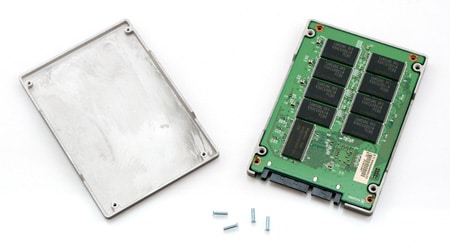
Taking apart the Plextor PX-128M1S was very easy with standard precision hand tools. The case is secured with four small Phillips-head screws and once all are removed, the case literally falls apart. Inside, the circuit board is seen sitting on top of the machined screw-holes “floating” in the middle of the case. Unlike quite a few SSDs we have seen recently, this one was not designed with thermal pads, which help transmit heat and absorb vibration.
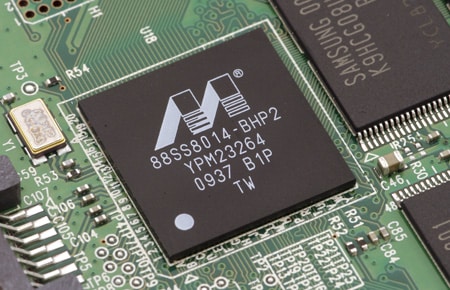
The circuit board layout is dual-sided with Plextor using of both sides to mount flash memory for the 128GB model. The controller is a Marvell branded 88SS8014-BHP2, code named “Da-Vinci.” The controller supports OS-independent TRIM or garbage collection.
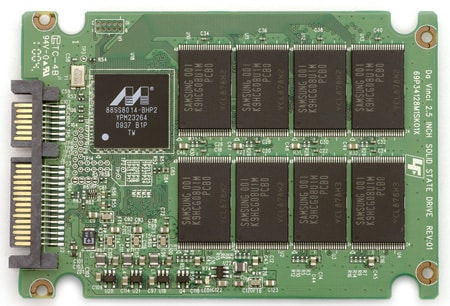
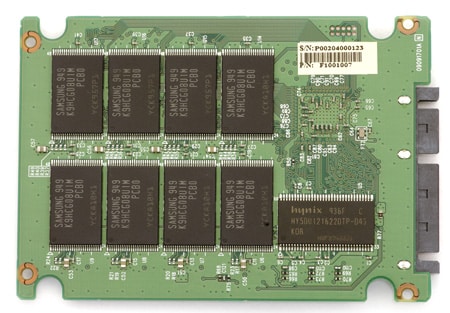
Plextor uses a Hynix memory module for this SSD, with the markings HY5DU121622DTP-D43 which indicate it is a 200MHz DDR 512Mb (64MB) chip. The flash chips are Samsung sourced 8GB models with the markings K9HCG08U1M. The 128GB drive makes use of 16 modules.
Benchmarks
The Plextor PX-128M1S SSD entered the market at a competitive time. In this review we put it head-to-head with the industry leading Intel X25-M and a pair of mid-range SSDs – the Western Digital SiliconEdge Blue, and Kingston SNVP325.
Plextor advertises a maximum sequential transfer speed of 130MB/s read and 70MB/s write. We were pleasantly surprised that after seeing significant prior write activity the PX-128M1S managed 185MB/s read and 89MB/s write. This is a 42% bump in read speed and 27% bump write speed compared to the claim.
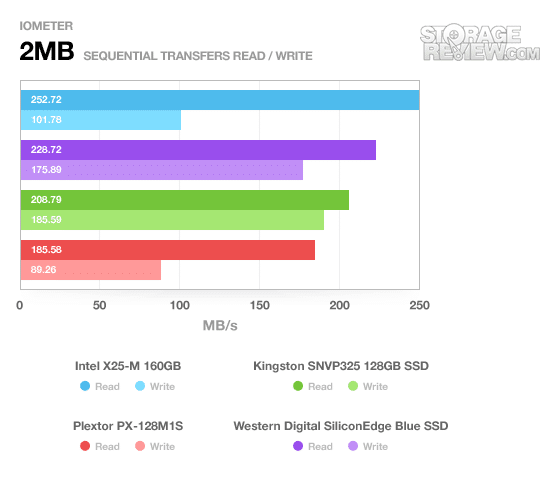
Our next test switches from sequential transfer to random transfer, but still maintains the same 2MB transfer size in IOMeter. In this test read and write speeds still stayed well above the advertised claims, with a measured speed of 161MB/s read and 86MB/s write.
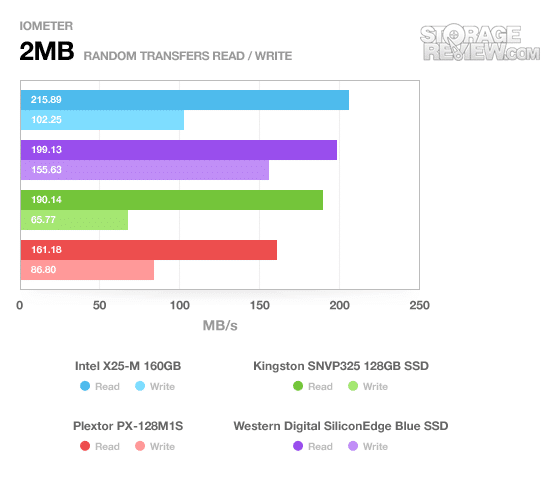
Our next test stresses the drive with very high I/O activity using 4K random transfer requests with IOMeter. The Plextor PX-128M1S managed 11.38MB/s read and 5.59MB/s write.
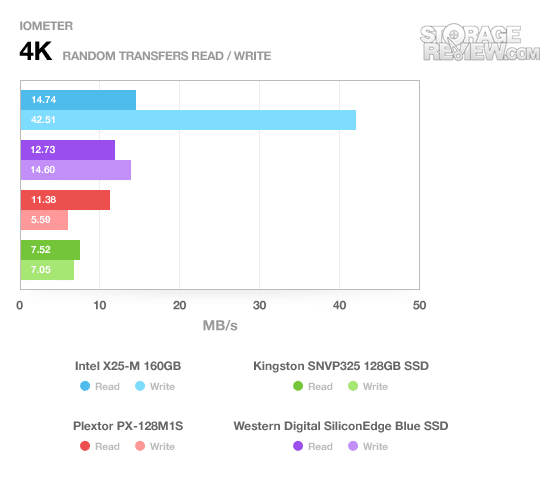
Plextor lists up to a maximum of 4,300 I/O read and 1,800 I/O write. In our tests we recorded 2,912 I/O read and 1,430 I/O write which is well under advertised claims.
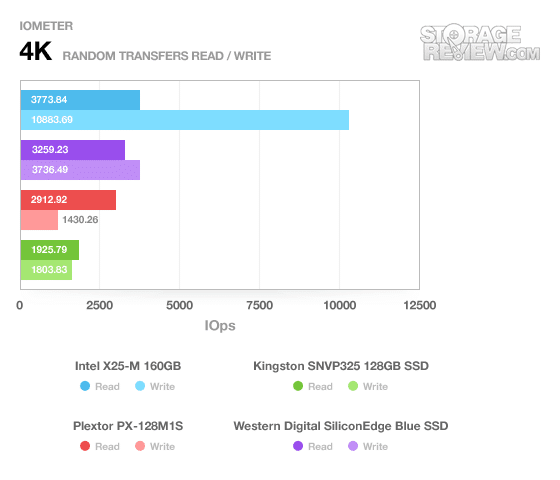
In our 4K write latency test the Plextor had the highest average coming in at 0.70ms, but had the lowest maximum response time of 8.66ms. It showed no signs of the dreaded SSD stutter that some drives suffer.
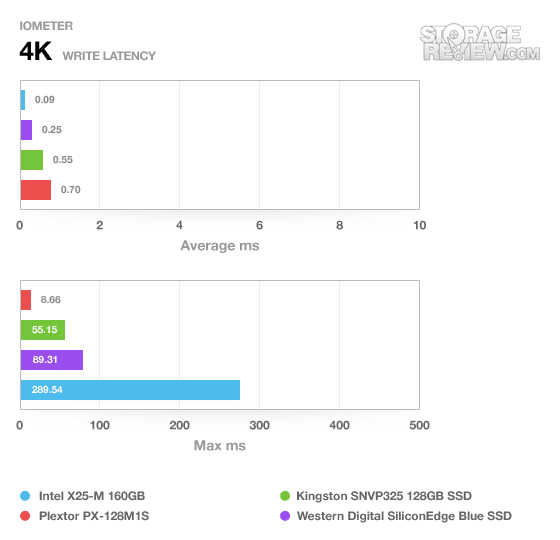
Running a 500MB test CrystalDiskMark showed very similar speeds to what was recorded in IOMeter.
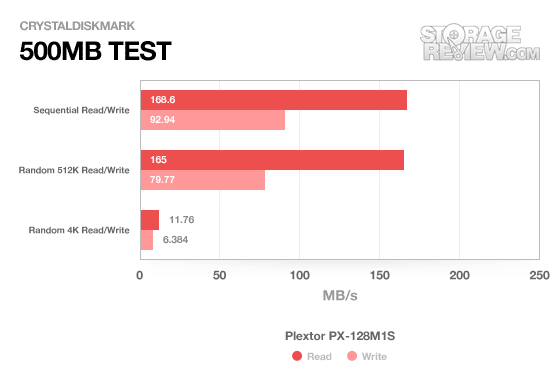
Next we turn to IOMeter server tests which give an idea of how well the drive performs under situations with multiple simultaneous transfer requests. This gives an indication of how well NCQ and other advanced features perform.
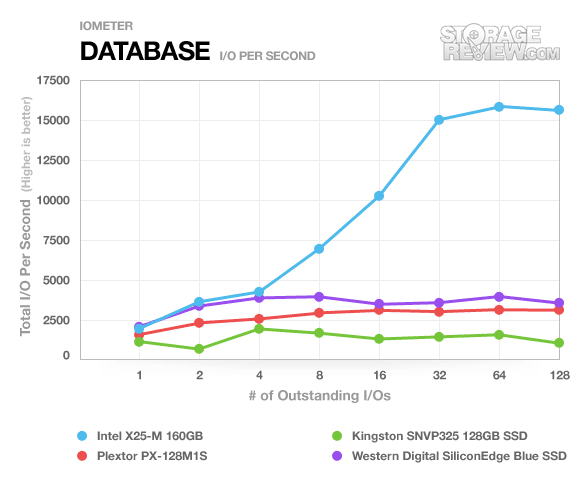
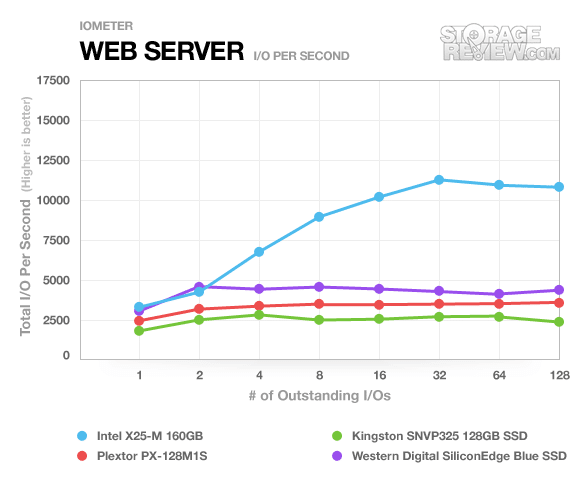
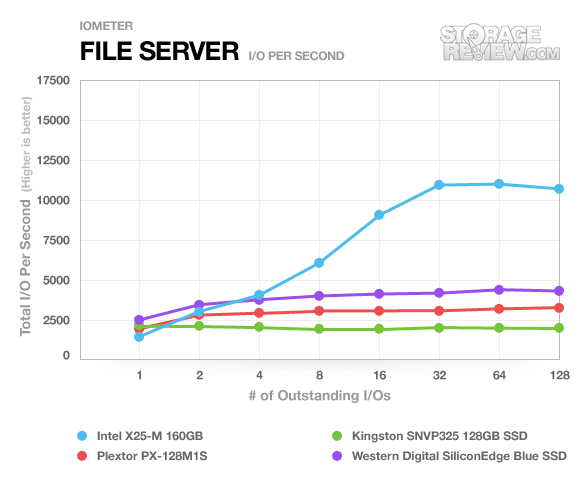
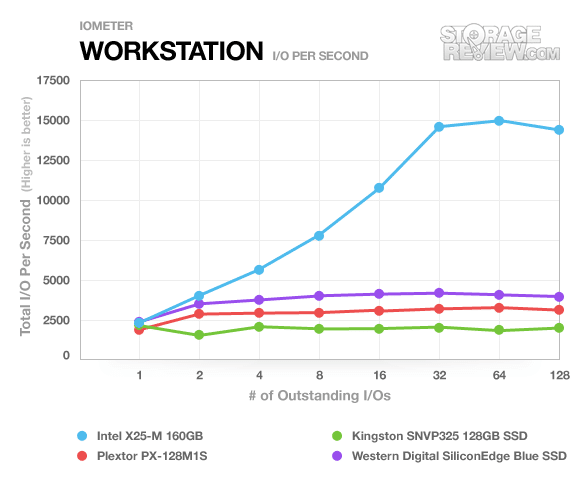
The Plextor PX-128M1S ran middle of the pack—not including the Intel X25-M which has an exponential lead—compared to the Kingston and Western Digital SSD. The drive didn’t see much, if any, gain as the transfer requests stacked up, unlike the Intel which took off like a jetliner. This is perhaps an indication that while the drive technically supports NCQ, it doesn’t take the best advantage of it.
For the average reader looking at our reviews it might be hard to translate high transfer speeds or random 4k performance into real-world performance. In some cases we have seen drives perform exceptionally well in transfer speeds but plummet when it came to our real-world test. With our custom StorageMark 2010 traces we hope that no matter what, any reader can see how drives stack up against each other in everyday situations.
The first real-life test is our HTPC scenario. In this test we include: playing one 720P HD movie in Media Player Classic, one 480P SD movie playing in VLC, three movies downloading simultaneously through iTunes, and one 1080i HDTV stream being recorded through Windows Media Center over a 15 minute period. Higher IOps and MB/s rates with lower latency times are preferred.
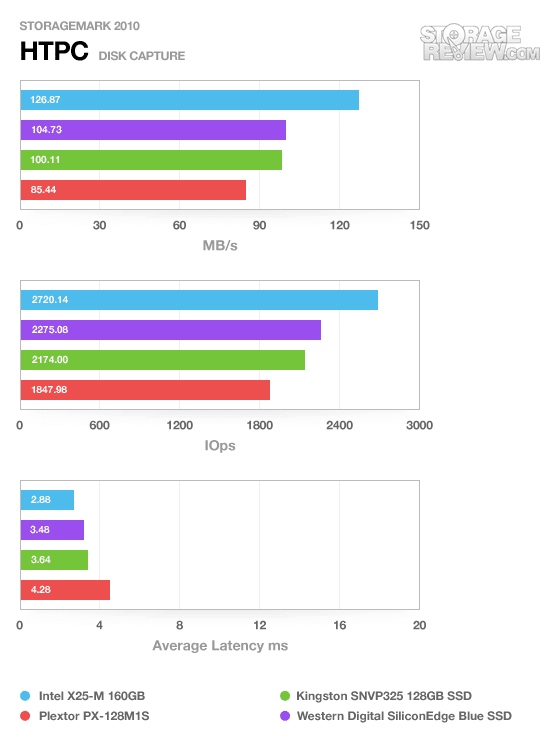
The Plextor fell behind in this test coming in 15% slower than the 128GB Kingston SNVP325. But take into consideration that its 85MB/s transfer rate is still more than twice the speed of the Western Digital 600GB VelociRaptor HDD.
Our second real-life test covers disk activity in a productivity scenario. For all intents and purposes this test shows drive performance under normal daily activity for most users. This test includes: a three hour period operating in an office productivity environment with 32-bit Vista running Outlook 2007 connected to an Exchange server, web browsing using Chrome and IE8, editing files within Office 2007, viewing PDFs in Adobe Reader, and an hour of local music playback with two hours of additional online music via Pandora.
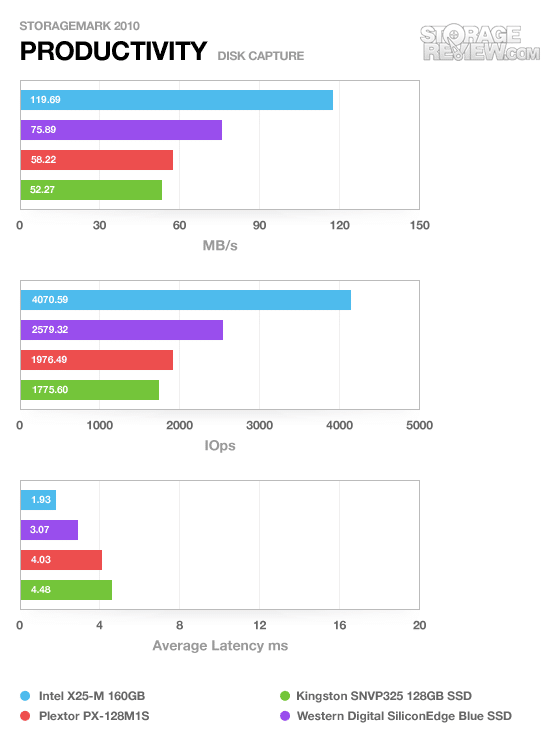
In this test the Plextor moved up from the last position into third, barely edging out the Kingston SVNP325.
Power Consumption
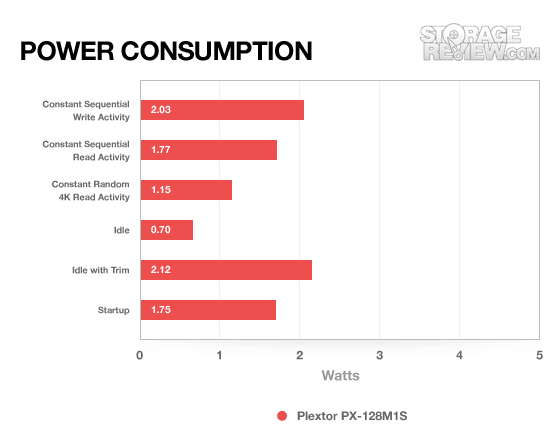
Compared to the manufacturers power claim of 0.75w consumed during read and write activity and 0.25wconsumed at idle, we measured the drive at a much higher level. Compared to other SSDs on the market the Plextor PX-128M1S isn’t out of line, but I do feel the drive was under estimated since we saw nearly three times the idle power rate and two to three times the read and write power rate.
Warranty
Plextor offers a three year warranty which is the industry normal for most SSDs. Intel, Kingston, and Western Digital all offer similar warranty time periods. When it comes to longevity ratings Plextor lists a Mean Time Between Failure (MTBF) of 1.5 million hours and that it can sustain up to 50,000 power on-off cycles. For the average user this translates into reliable performance over the useful life of the product it is installed in.
Conclusion
The Plextor PX-128M1S isn’t the fastest SSD on the block, but it isn’t the slowest either. Compared to models like the SiliconEdge Blue and Kingston SNVP325 it runs middle of the pack, which also means it runs significantly slower than the current frontrunner SSD; the Intel X25-M. Right now if you are shopping on price alone the 128GB PX-128M1S costs $329 online which translates to $2.57 per GB whereas the Intel X25-M sells for $449 in its 160GB configuration ($2.81 per GB).
For a lot of buyers, having the fastest SSD isn’t the most important factor in making a decision. In cases where budget is a significant issue, the Plextor is a viable mainstream SSD option when the price is right.
Pros
- OS-independent TRIM/Garbage Collection
- Reasonable retail price
- Very low max latency
Cons
- Not as quick as other SSDs in this class
Bottom Line
The Plextor PX-128M1S offers mid-range performance for a mid-range price, which isn’t bad for a first generation SSD. We’re encouraged by Plextor’s effort and look forward to their next effort.


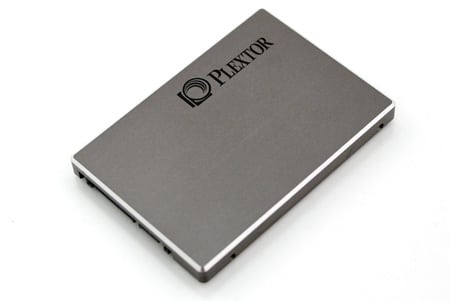
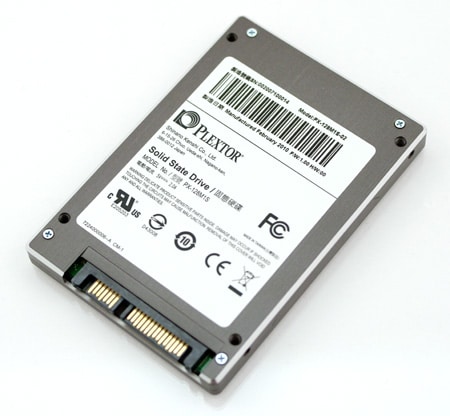


 Amazon
Amazon